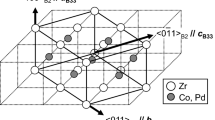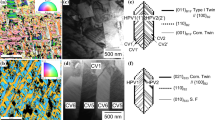Abstract
Microstructural evolution during tensile deformation in ternary Zr–Co–Ni alloys were investigated using transmission electron microscopy to clarify the mechanism of the enhancement of ductility observed in these alloys. In Zr50Co39Ni11 alloy deformed at room temperature, lenticular martensite is observed in the B2 parent phase immediately after yielding, in addition to dislocations with the <100>B2-type Burgers vector. The orientation relationship between the B2 parent phase and B33 martensite is determined to be [001]B2//[100]B33, (010)B2//(021)B33, and (110)B2//(010)B33. A midrib-like contrast is observed at the center of the lenticular martensite variant, and it is found to be a (021)B33 twin. A trace analysis indicates that this contrast is nearly parallel to the {100}B2, which may correspond to the habit plane of the martensite. The martensite variants grow into the B2 parent phase along the {100}B2 with increasing tensile loading, and then grid-shaped martensite variants are formed at the failure of the specimen. The martensite would be dominantly formed and grow in the regions where the stress concentration occurs during tensile deformation. It is likely that the plastic deformation mainly proceeds in the untransformed B2 parent phase because this martensite is harder than the B2 parent phase. Consequently, the authors conclude that the remarkable enhancement of ductility can be attributed to a transformation-induced plasticity associated with deformation-induced martensite.









Similar content being viewed by others
References
Ishida K, Kainuma R, Ueno N, Nishizawa T (1991) Metall Trans 22A:441
Tawancy HM, Aboelfotoh MO (2010) J Mater Sci 45:3413. doi:10.1007/s10853-010-4366-y
Nishida M, Tanaka K, Ii S, Kohshima M, Miura S, Asai M (2003) J Phys IV 112:803
Yamaguchi T, Kaneno Y, Takasugi T (2005) Scr Mater 52:39
Carvalho EM, Harris IR (1985) J Less-Common Metals 106:143
Hossain D, Harris IR, Barraclough KG (1974) J Less-Common Metals 37:35
Matsuda M, Hayashi K, Nishida M (2009) Mater Trans 50:2335
Bilby BA, Crocker AG (1965) Proc of Roy Soc Ser A 288:240
Mohamed HA, Washburn J (1977) J Mater Sci 12:469. doi:10.1007/BF00540269
Adachi K (1988) Bull Japan Inst Metals 1:21
Tamura I, Maki T (1971) In: Proceedings of the international conference on toward improved ductility and toughness, Kyoto, pp 183–193
Acknowledgements
This study was supported by a “Grant-in-Aid for Scientific Research (B)” from the Japanese Society for the Promotion of Science (JSPS)” and a “Grant-in-Aid for Young Scientists (B)” from the Ministry of Education, Culture, Sports, Science and Technology (MEXT), Japan.
Author information
Authors and Affiliations
Corresponding author
Rights and permissions
About this article
Cite this article
Matsuda, M., Nishimoto, T., Matsunaga, K. et al. Deformation structure in ductile B2-type Zr–Co–Ni alloys with martensitic transformation. J Mater Sci 46, 4221–4227 (2011). https://doi.org/10.1007/s10853-010-5236-3
Received:
Accepted:
Published:
Issue Date:
DOI: https://doi.org/10.1007/s10853-010-5236-3




